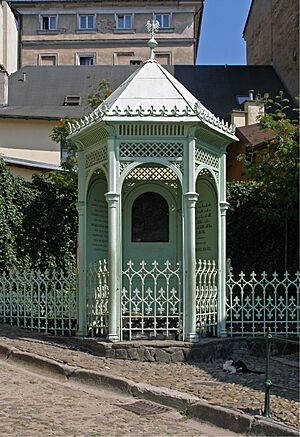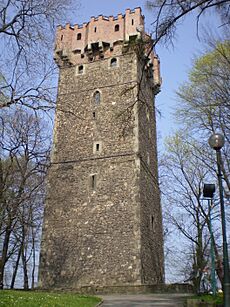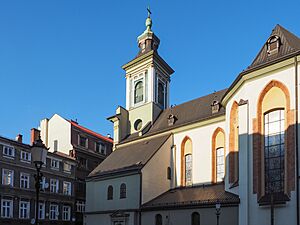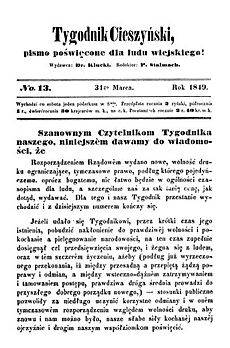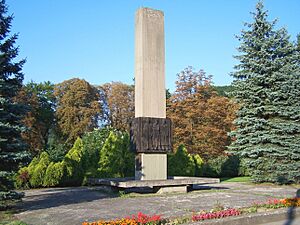History of Cieszyn facts for kids
Cieszyn is a very old town in a region called Silesia. Its history goes back to at least the 7th century. It's known for its rich past and unique location, split between two countries today.
Contents
History
Early Beginnings of Cieszyn
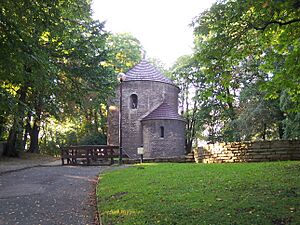
Cieszyn is one of the oldest towns in Silesia. People called Slavs lived here as early as the 7th century. They were part of a group known as the Golensizi tribe.
There's a fun legend about how Cieszyn got its name. In the year 810, three sons of a Slav king – Bolko, Leszko, and Cieszko – met here. They had been on a long journey. They found a spring, and they were so happy that they decided to build a new settlement. They supposedly named it Cieszyn, which sounds like the Polish and Czech words for "to be happy." You can still see this well on Three Brothers Street today.
A more scientific idea for the name is that it comes from an old Slavic name like *Ciecha or *Ciesza. The town grew up around Castle Hill. This hill has signs of people living there since the 6th or 7th centuries. A strong fort, called a gród, was built on the hill. It became an important place for ruling and religion. A castle and a Romanesque chapel were built there in the 11th century. The chapel is still standing and is even on a Polish banknote!
Cieszyn Under Piast Rulers
The area became part of the new Polish state in the 10th century. This was under the Piast dynasty. The first time Cieszyn was mentioned in writing was in 1155. A document from Pope Adrian IV talked about the castle of Tessin.
Around the castle, a town slowly grew. It was built on a strong piece of land above the Olza River. The first church was built there before the 12th century. In 1223, Cieszyn was clearly called a "castellany," meaning it had a castle and a ruler. The town likely had "city rights" even before 1290. These rights were officially confirmed in 1374. A new church was also built near the first market square around 1240.
Cieszyn's history was similar to the rest of Silesia. After Poland split into smaller parts, Piast dukes from the Silesian family ruled the area. Cieszyn became the main town of the Duchy of Cieszyn. In 1327, Duke Kazimierz I promised loyalty to the King of Bohemia. From then on, Cieszyn became a special part of the Kingdom of Bohemia.
As the capital, Cieszyn grew quickly and became more important. It also became a religious center. The town grew a lot when Przemysław I Noszak was duke. He made sure Cieszyn got its city rights in 1374. He also rebuilt the wooden castle into a stronger brick one. This was when the town got its first mayor and city council.
Another time of fast growth was during the rule of Casimir II. He built new things in the town, like defense walls. He also created a new market square and gave buildings for a new city council. These buildings are still used today! In the 16th century, Cieszyn became a big center for trade. It was known for making weapons and jewelry. It also became a center for the Protestant Reformation.
The town kept growing until the 17th century. Then, it was badly damaged during the Thirty Years' War. This war caused a lot of economic problems and a drop in population for the whole region.
The Piast family ruled Cieszyn until 1653. The last ruler was Duchess Elizabeth Lucretia. After she died, the duchy became part of the Kingdom of Bohemia. At that time, the Habsburg family ruled Bohemia. When the Habsburgs took over, Cieszyn's economy and politics didn't grow much until the end of the century.
Cieszyn Under Habsburg Rule
After a period called the Counter-Reformation, a large Lutheran church was built in Cieszyn between 1709 and 1750. Cieszyn became more important after the Silesian Wars in the 18th century. Cieszyn Silesia remained part of Austria. In 1779, a peace treaty was signed in Cieszyn. This treaty ended a war between Austria and Prussia. In 1772, Cieszyn was also the main meeting place for the Bar Confederation, a group of Polish nobles.
A big fire in 1789 damaged almost the entire town. From the late 18th century, German culture became more common in Cieszyn.
In the 19th century, Cieszyn saw a lot of cultural and educational growth. In 1802, a priest named Leopold Szersznik started a museum. This museum later became the Museum of Cieszyn Silesia. It was one of the first public museums in Polish lands. In 1839, the old Piast castle was finally taken down. A new, more modern castle was built in its place.
Another fire hit Cieszyn in 1836. It destroyed part of the town center, including the town hall. The town hall was rebuilt in 1846 and looks the same today. A brewery was also built near Castle Hill in the same year. During the Spring of Nations in 1848, Cieszyn became an important place for Polish national ideas. That year, the first Polish newspaper in the region, Tygodnik Cieszyński, was published.
After the Revolutions of 1848 in the Austrian Empire, a new way of organizing towns was started in Austrian Silesia. Cieszyn became the center of a political and legal area.
In 1869, a railway line reached Cieszyn. A train station was built on the left side of the Olza River. This area is now part of Český Těšín. Building the train station caused the left side of the town to grow quickly. This part became the industrial area. Even though a nearby town, Bielsko, was more industrial, Cieszyn remained an important center for administration and culture.
By the end of the 19th century, most people in Cieszyn were Germans and Poles. Germans were the majority in the town itself. However, Poles were the majority in the whole region. There were also many Jewish and Czech people, and sometimes a few Hungarians.
Official counts showed that the town's population grew from 13,004 in 1880 to 22,489 in 1910. More and more people spoke German as their main language. In 1910, 61.5% spoke German, while 31.7% spoke Polish. Czech speakers were a smaller group. Most people were Roman Catholics (67.3%), followed by Protestants (23%) and Jews (9.4%). The local people traditionally spoke a dialect called Cieszyn Silesian dialect. The increase in German speakers was partly because German was a very important language at the time.
In 1911, a tram line was built. It crossed the Olza River, connecting the train station on the left bank with the town center on the right bank. During World War I, Austrian soldiers were stationed in Cieszyn. The main army leaders even set up their headquarters there for a while.
Cieszyn Between the World Wars
The area around Cieszyn was rich in coal and had important railway lines. Both Poland and Czechoslovakia wanted to control it. After World War I, local Poles and Czechs each set up their own governments. Both groups believed the whole Cieszyn Silesia region belonged to their new country.
To reduce fighting, the local groups made a temporary agreement in November 1918. They decided to divide the area based on who lived there. However, by 1919, the main governments in Prague (for Czechoslovakia) and Warsaw (for Poland) took over. The Czechs felt the division was unfair. The railway line that went to eastern Slovakia was very important. Czechoslovakia needed access to this railway because it was fighting a war over Slovakia. This situation led to conflict.
Even though the division was only temporary, Poland decided to hold elections for its parliament in the area. Czechoslovakia argued that no country should claim the area before a final decision was made. They asked Poland not to hold the elections. Poland refused. So, Czechoslovakia attacked the Polish part of the region on January 23, 1919. They forced Poland to leave the western part of Cieszyn Silesia. Poland was also fighting another war at the time. After a battle near Skoczów, a ceasefire was signed in Paris in February 1919.
In 1920, Poland had to accept new borders along the Olza River. Czechoslovakia received the western part, which included important coal mines and the railway line. They also got a smaller western part of the town, which later became Český Těšín. Poland received the eastern part with Cieszyn and its historic center.
During the years between the wars, two nearby villages joined Cieszyn: Błogocice in 1923 and Bobrek in 1932.
Poland sometimes claimed the Czech part of the town. In October 1938, after the Munich Agreement, Poland took control of it.
Cieszyn During World War II
After Germany and the Soviet Union invaded Poland in September 1939, starting World War II, the entire town was occupied by Germany. This lasted until 1945. From 1939 to 1940, the Germans arrested many local Poles. This was part of a terrible plan to eliminate Polish leaders and thinkers. Many Polish teachers, priests, and activists were sent to concentration camps and killed.
The Nazi prison in Cieszyn had two subcamps where people were forced to work. There were also two more in nearby towns. The Germans also set up a camp for very young children, up to 2-3 years old. These children were hurt and even used for medical experiments. In 1941, the occupiers created a prisoner-of-war camp for Polish, French, Belgian, British, and Serbian soldiers. Later, this camp became a subcamp of a larger one. The Germans also had another forced labor subcamp in the Krasna district.
After the war in 1945, the borders from 1920 were put back in place.
Cieszyn After the War
After World War II, both Cieszyn and Český Těšín grew by adding nearby villages. Several villages joined Český Těšín between 1947 and 1975. Similarly, many villages like Boguszowice, Krasna, and Marklowice joined Cieszyn in the 1970s.
See also
- Border conflicts between Poland and Czechoslovakia
- Duchy of Teschen


